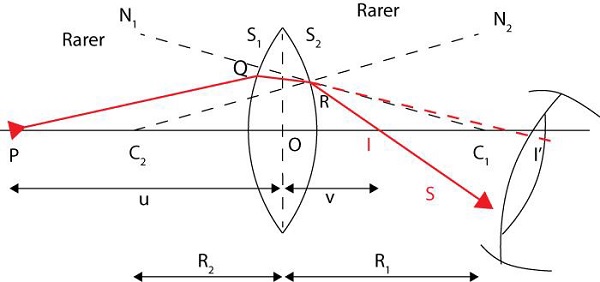Lens Makers Formula
Description:
For various optical instruments, lenses of different focal lengths are used.
Focal length of a lens depends upon radii of curvatures of two surfaces and refractive index of the lens material.
Lens maker’s formula is used by lens manufacturers for making lenses of desired focal lengths.
Consider a thin glass lens having centers of curvatures C1 and C2 with radii of curvatures R1 and R2 respectively as shown in figure −

When a point object ’P’ is kept on principle axis which is formed by joining the centers of curvature, one ray passes along the principle axis without deviation.
Other ray PQ is refracted along QR due to first surface at a point ‘Q’, if there was no second surface then the refracted ray would have reaches the point I’, but due to second surface, the ray undergoes another refraction at point R and reaches at point I.
For refraction at surface-1 −
When ray moves from rarer to denser medium, we have −
μ2v - μ1u = μ2 - μ1R
From figure, we get −
v = OI′ and u = OP and R = OC1
Putting values −
μ2+OI′ - μ1-OP = μ2 - μ1-OC1
∴ μ2+OI′ + μ1OP = μ2 - μ1OC1...........(1)
For refraction at surface-2 −
When ray moves from denser to rarer medium, we have −
μ1v - μ2u = μ1 - μ2R
From figure, we get −
v = OI and u = OI′ and R = OC2
Putting values −
μ2+OI - μ1+OI′ = μ1 - μ2-OC2
∴ μ2OI - μ1OI′ = μ2 - μ1OC2.......(2)
Adding equation 1 and equation 2, we get −
μ1OI + μ1OP = (μ2 - μ1)(1OC1 + 1OC2)
Now, from figure considering values for lens −
OI = +v and OP = -u
Putting values for lens −
μ1v + μ1-u = (μ2 - μ1)(1R1 + 1-R2)
μ1(1v - 1u) = (μ2 - μ1)(1R1 - 1R2)
Therefore,
1f = (μ2μ1 - 1)(1R1 - 1R2)
Writing in terms of power −
P = (μ21 - 1)(1R1 - 1R2)

